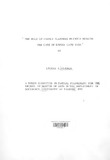| dc.description.abstract | High population growth rate is the most disturbing problem to a developing country such as Kenya. Policy-makers in Kenya have been prescribing varIOUSmeasures aimed at slowing down the population growth rate to no avail. High among the measures prescribed is the introduction of the family planning programme. The major justification for its introduction is economic development.
It is the main argument of this study that an important aspect for the introduction of family planning has been largely ignored. This aspect on which the study has placed much emphasis is health, particularly that of children. It is suspected that the continued rise in population numbers in spite of the concerted effort by various organizations, could be the result of this ignorance. Child health is a matter of great concern to parents, and they are most receptive to factors that influence their children's health. Family planning (birth spacing) has such influence. The health benefits accruing from birth spacing are thus considered important. It is the contention of this study that emphasis placed on the health aspect may go a long way in enhancing the few achievements of family planning "in reducing population numbers.
The aim of the study is to show birth spacing as an important determinant of child health. It also examines the influence of other selected factors such as maternal education, age, occupation, family size and household
11
income on child health. These selected factors, it is noted, may influence child health indirectly by influencing the spacing habits of women, or they may have a direct influence on child health without the mediating role of birth spacing.
The sample for this study was all female. The individual women with the following characteristics was the unit of analysis: married mothers and unmarried mothers with at least two children aged between 0 and 5 years. A total of eighty respondents were interviewed.
The sample was selected using the snowball method of sampling and simple random sampling. Simple observation and child welfare cards were other methods of data collection. Data were collected using the interview schedule technique (questionnaire). The questionnaire consisted of both closed and open-ended questions.
To assess the validity of the study's argument, up to three major hypotheses were formulated for testing. The chi-square test (x~ and Contingency Coefficient (C) were the statistical tools adopted to test the hypotheses.
According to the study'S findings, birth spacing is related to child health.
It was confirmed that the longer the spacing among siblings, the better their health status. Maternal education was found to influence the health of children directly without the mediating role of birth spacing. No significant
relationship w-a-s noted between maternal education and birth spacing, thus
111
dismissing the indirect relationship of maternal education and child health VIa birth-spacing. All other selected independent variables (maternal occupation, family size, household income) were found to have the expected influence on the health of children. An exception to this was the maternal age variable which exhibited no significant relationship with child health both directly and indirectly via birth-spacing.
It was therefore concluded that in Kibera Laini Saba, birth spacing is
a major determinant of child health, relative to other selected factors which were found to influence the spacing habits of women and consequently the health of their children. It is thus necessary to underscore the importance of spacing children for the sake of better health. It is also necessary to promote the factors that are conducive to better family formation patterns.
This study suggests that more emphasis be placed on the health aspect of family planning than has so far been done. Birth spacing as an aspect of family planning is suggested to be a priority aspect in ensuring better health for children. | en |

